 |
The Blue-Screen-Effect |
 |
 |
The Blue-Screen-Effect |
 |
Actually this trick effect shoulb be well known. Finally it has been used for many years already. However, the one or another didn't thought about it. Well, those who know the effect already have to correct me if I say something wrong.
For a movie, as much scenes as possible have to be shoot in a studio (in a more or less hall. The reason is that there are less disturbing noises, light problems and so on. Furthermore the expensive cameras and the electronics are better protected. That's why all possible scenes are simulated in a studio. It is quite simple at a breakfast room or an attic but it makes real problems at bigger landscapes. The studio has only limited space. One solution is to paint the background at the background screen. In many cases this has an artificial effect, has no real depth and fails at all at moved scenes. In the early history of the filming the moved background sequence was diplayed in back projection or front projection onto the screen. Because of the ploblems with well-focussing at different depths this method was changed to the Blue-Screen-Technics.
How it woks I want to explain at Atreyus flight on the back of the Luck Dragon. Like at the old method the background is shut seperatly. (My example uses a part of the backside image of the The Neverending Story Picture Album and a part of another flight scene from the book The World of the Neverending Story).
 |  |
The fore-ground scene is shut in front of a giant blue screen. Bright blue is used because this color is hardly appear in the natur. This is important because all parts of the fore-ground in blue becomes transparent later. In priciple every other color would be same possible.The problem for the crew ist to create a regular blue overr the whole screen. That means a equal lighting (at the NES it were 800 lamps) and a perfect plane surface to avoid shadows. Normally blue nylon fabrics. This makes the screen veyr sensitive. During the film shooting of the NES one screen was teared one time over 20 m. A big loss with costs around 100,000 Marks ($ 50,000). Two inverse mask are produced from the shut scene with a blue-filter. They are called Travelling Mattes. One produces only the needed background and the other the required fore-ground.
 |  |
With a special optical device, the Optical Printer, the fore- and background were masked. That mean they were added, the light is beamed though both masks. In our example only the flying Atreyu remains in the fore-ground and in the background only those mountains that aren't hidden by Atreyu and Falcor.
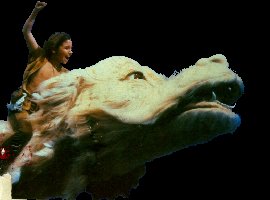 |  |
Both light ways were unified by half-pervious mirrors to a single beam. It exposed the raw film.

Everybody can assess the resul of my experiment by yourself. The method has also weaknesses, of course. You see the fleecy fur of the Luck Dragon makes problems at the siluette. There we see a mixed blue color which is not recognized by the blue-filter and remains in the endfilm. It is very interesting that you see this effect especially a the moved images but not at a single image. It seems that the eye detect this blue mixed tone at most by the high frequent changes. Now a few other examples where the Blue-Screen-Technics was used in the NES.
Falcor from ahead:
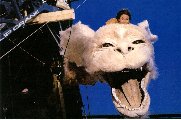
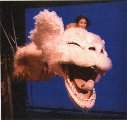



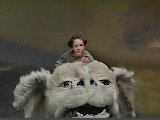


Falcor from the side (with different backgrounds):
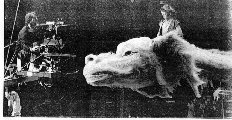







Falcor from behind (I have only images with Bastian, but there are also scenes with Atreyu in the film):
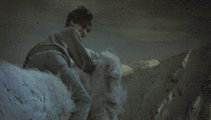
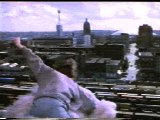

Atreyu at the beach:

Who can tell me more about this topic pleas send me a
mail
 .
.